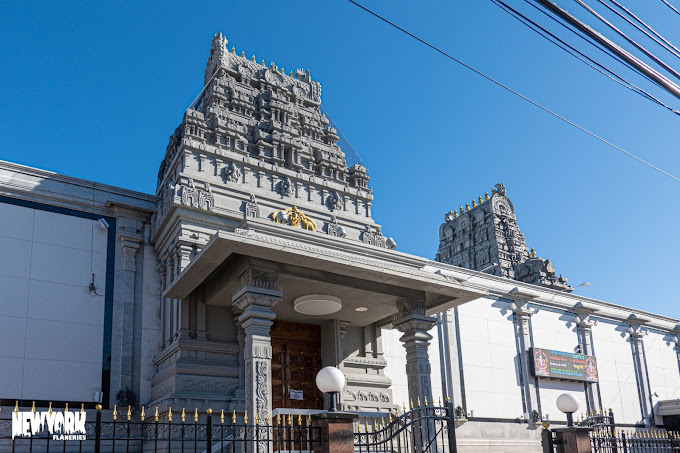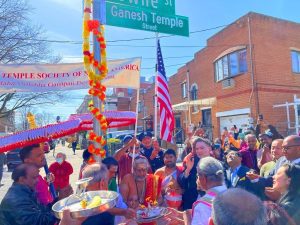
How Ganesha temple built by Indian immigrants came up in Flushing, New York
A personal reminiscence of how one of the earliest Hindu temples in the US came up – it’s a history no immigrant of the 1970s can read with a dry eye

In April 2022, Bowne Street in Flushing, Queens, an old neighbourhood in New York City, was given an additional name — Ganesh Temple Street. On social media, people shared videos of a modest crowd that cheered the unveiling of a small street sign that represented a huge landmark for Indian immigrants in the United States.
The elementary school I attended stands on that same Bowne Street. The school was named after Andrew Jackson, a 19th century US President now chiefly remembered for owning slaves and making war on Native American tribes. The street was named after John Bowne, a 17th century Quaker (hence a pacifist and probably an abolitionist), who fought for religious freedom in a new colony, and won.

These ironies soared well above the head of an eight-year-old who landed in Flushing in March 1971. I had lived a sheltered existence in the tidy company town of Durgapur, and to me the walk between our apartment and a clanging, teeming three-story school was confusing and sometimes frightening. Our school had an airy and elegant Italianate front that I discovered only years later—we students used to enter from the grim backyard, through the gates of extra-high chain-link fences. The neighbourhood was gritty. The students came in every colour and spoke many languages before they all mastered American English.
At some point, my father heard about a “temple” right near my school, open for worship every Sunday morning. It was in fact an old house that had been used as a Russian Orthodox Church for a while, and now it was owned by the Hindu Temple Society of North America. The history of the society, of its founder Alagappa Alagappan, and of the Ganesh Temple is now well documented, and it’s a history no immigrant of the 1970s can read with a dry eye. Behind that history lie the memories of many children like me.
Also read: Indian-Americans: A community built on grit, hard work, and being on the right side of law
Every Sunday we went to the temple, dressed in thin Indian clothes and thick American coats. Inside, most of us kept our coats on, because it was damp and there were drafts near the windows. Occasionally, a slug crept under the rotting base of the door and across the thin carpet. We sat facing an oil lamp and a collection of framed pictures leaning against the large logo of the society, a lotus with an Om, a cross, a crescent, and other religious symbols on the petals.
There was a simple service, followed by bhajans, and the mass of well-trained voices made us all sound musical. Afterwards, in the dark basement, we shared prasadam brought from home and made new friends. I was too young to reconcile this experience with my few and fading memories of other temples, but every Sunday we seemed to step back into India for a morning.
One day I noticed a framed architect’s drawing on the wall, showing a long side elevation with a gopuram at one end. By then I was ten or so, a skeptic bred in an inner-city school. Is our temple ever going to look like that, I wondered. The early immigrant families rented one-bedroom flats, “adjusting” as needed to accommodate visitors and newcomers, and saved every penny. The drawing seemed a dream. But the grown-ups clearly knew what they were doing, because one day the old building was demolished, the earth was dug up, and foundations were poured. For years afterwards, the smell of wet concrete transported me to Bowne Street.
We kids were not just spectators. The call went out for pages filled with “Sriramajayam” to bury in the foundation, and we all got busy at home, writing the sacred word all summer long in English, Tamil, Sanskrit and whatever other script we knew. We continued to observe our holy days in the half-built structure, blinking away the dust and watching the shilpis who came from India to carve the dream.
Also read: Indian-Americans in Atlanta raise USD50K to support orphanage project of Sadhvi Ritambhara
The events were all do-it-yourself back then. We cooked the prasadam at home, we served it, we lined up the chairs, we sang, we applauded. Afterwards, we washed the dishes, bagged the trash, stacked the chairs and swept the floor. A community was rising, not just a house of god.
It was during the fund raising that we kids discovered Amar Chitra Katha, priced at ten dollars a comic book. Five decades on, the stories of Savitri and Rana Pratap are still woven in with my memories of our temple. And our dream came true. We had an actual priest, we had a gopuram, we had a Ganapati inside a sanctum, a Mahavishnu, a Sivalingam, a Navagraha platform, we had bells and oil lamps—in short, we had a little piece of our janmabhoomi on Bowne Street, a piece many of us children had not even seen before. In the spacious basement, we met after the services to share prasadam, but also to learn music and dance and to watch concerts and hear harikatha, and celebrate weddings.
Also read: 1 pc of US population, Indian-Americans pay 6 pc of taxes: Congressman
They paid off the mortgage in half the time. There is a chariot procession now, and a canteen, and—as one would expect from an institution completing its fifth decade—there is the confidence of a community thriving in a hard-won home. I probably wouldn’t find my way around now without someone to point me in the right direction. But those of us who grew up with the Ganesh Temple on Bowne Street will always remember the faith that overcame childish doubts and revel in a success beyond what we imagined.
Latha Anantharaman is a writer, editor and translator now based in Kerala


